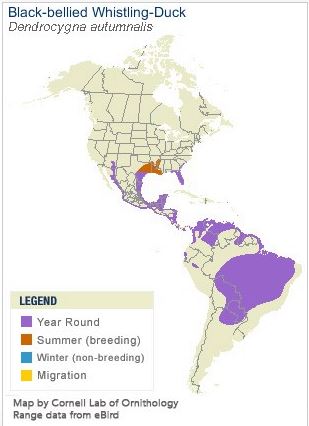
Black-bellied Whistling ducks (Dendrocygna autumnalis) range from southern Arizona, south Texas and Louisiana, through parts of Mexico and Central America to Brazil. Their range is expanding northward.
 These large ducks (body length about 22 inches, wingspan 37 inches) are reddish brown, have a black belly, white wing patches, and a pink to orange bill. They are long-legged, long-necked, and are sociable and noisy. The Cornell Lab of Ornithology describes them as “boisterous.”
These large ducks (body length about 22 inches, wingspan 37 inches) are reddish brown, have a black belly, white wing patches, and a pink to orange bill. They are long-legged, long-necked, and are sociable and noisy. The Cornell Lab of Ornithology describes them as “boisterous.”
My own experience with these ducks is confined to the mixed-species aviary at the Arizona-Sonora Desert Museum. Often, a gang of these noisy ducks will follow me around, pecking at my legs and attempt to untie my shoelaces.
Whistling ducks can be found in marshes, ponds, and lakes where they feed on aquatic animals such as snails. Their main diet, however, consists of seeds and grains. Whistling ducks frequent grasslands and agricultural areas where they feed on many agricultural crops including sorghum, millet, corn, rice, and wheat. They also eat insects and spiders.
Whistling ducks are casual about nesting. According to the Cornell Lab of Ornithology: they usually nest in tree hollows where a limb has broken or the trunk has rotted away. They typically don’t build a nest; they lay their eggs directly on whatever debris has collected there. Cavity openings range from 5–12 inches across. When nesting on the ground, they make a scrape or a shallow bowl of grasses, with thick vegetation overhead, such as willow, mesquite, or cactus. They typically lay 9 to18 eggs which are incubated for 25 to 30 days. Hatchlings are nearly independent upon hatching.
About the noise. Whistling ducks do not make the “quacking” noise of other ducks. Rather they have a range of sounds. Listen here.
According to ASDM, United States populations are increasing, probably because of nest boxes. This species was rare in Arizona before 1949 but has since become a rather common nesting bird.
Note to readers:
- Index with links to all my ADI articles: http://wp.me/P3SUNp-1pi
- My comprehensive 28-page essay on climate change: http://wp.me/P3SUNp-1bq
- A shorter ADI version is at https://arizonadailyindependent.com/2013/08/01/climate-change-in-perspective/
